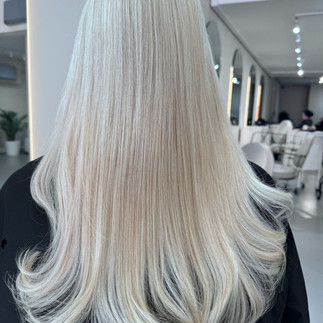The Ultimate Hair Care Routine: Achieve Healthy, Shiny Hair Tailored to Your Hair Type
- chris33878
- Feb 21
- 5 min read
Updated: Feb 28
Taking care of your hair isn’t just about using the right products—it’s about developing a personalised hair care routine that works for your unique hair type and individual hair needs. Whether you’re aiming for smoother, shinier locks or trying to boost volume and texture, understanding your hair type is the first step toward healthy hair. A well-planned haircare routine incorporates essential steps like cleansing, conditioning, moisturising, and styling, all of which can help maintain your hair’s health and appearance.
In this guide, we’ll walk you through how to create the best hair care routine tailored to your hair type. From straight to curly, fine to coarse, we'll explore the steps you should take to give your hair the care it needs to thrive.
Understanding Your Hair Type and Needs
The right hair care routine begins with understanding your hair type. Your hair’s texture, moisture level, and overall condition will determine which products and techniques work best for you. Everyone's hair has different needs, and knowing your hair type is key to achieving your hair goals.
Hair Type Categories
Straight Hair: Sleek and shiny, but prone to oil buildup as sebum travels easily down the hair shaft. This type benefits from lightweight products to avoid looking limp.
Wavy Hair: Featuring natural S-shaped waves that can vary from loose to defined. Wavy hair often needs moisture and frizz control.
Curly Hair: Defined spirals or corkscrew curls that require extra hydration and care to maintain bounce and prevent frizz.
Kinky Hair: Very tightly coiled, dense hair that’s prone to dryness and breakage. It benefits from deep conditioning treatments and protective styling.
Common Hair Concerns and How to Address Them
Hair care isn’t one-size-fits-all. Every routine shares the goal of maintaining healthy hair, but your individual hair may face unique challenges. Let’s explore some common hair concerns and how to treat them.
Dry Hair: If your hair feels brittle or rough, it may be lacking moisture. Use hydrating hair masks and hair oils regularly to restore moisture and improve texture.
Oily Scalp: Excess sebum production can lead to greasy hair. A hair care routine for oily hair should include frequent cleansing and lightweight products to prevent buildup.
Flaky Scalp: Dead skin cells and dandruff can be uncomfortable. Consider using a gentle exfoliating scalp scrub or a specialised anti-dandruff shampoo.
Damaged Hair: Whether from heat, chemicals, or environmental factors, damaged hair needs extra care. Hair treatments and deep conditioning are essential to restore strength and shine.
Hair Loss: Thinning hair may require more delicate handling. Focus on gentle detangling, and consider hair growth treatments or oils that stimulate the scalp.
Steps to Build the Perfect Hair Care Routine
To keep your hair healthy and shiny, a healthy hair care routine is essential. Each step is designed to nurture your strands, protect them from damage, and keep them looking their best.
Here’s a guide to a perfect hair care routine that can work for any hair type:
Step 1: Cleansing and Scalp Care
Cleansing is essential to remove excess oils, dirt, and product buildup. However, washing your hair with hot water can strip it of its natural oils, so it’s better to use lukewarm water when cleansing. Apply shampoo to the scalp and massage gently to stimulate circulation. If you have an oily scalp, you may need to wash your hair more frequently.
Tip: A scalp scrub once every 7-14 days can help promote healthy hair growth and remove dead skin cells.
Step 2: Conditioning and Hair Treatments
After cleansing, use a conditioner to hydrate and seal the hair cuticle. Focus conditioner application on the mid-lengths and ends, where hair tends to be drier. For damaged hair, a deep conditioning treatment is necessary once a week to restore moisture balance and improve overall hair health.
Tip: Use a leave-in conditioner or hair oil between washes for added moisture, especially if you have dry or curly hair.
Step 3: Drying and Detangling
Avoid towel drying your hair with a rough towel, as it can lead to breakage. Instead, opt for a microfibre towel or a cotton T-shirt to gently blot out excess water. When detangling your hair, use a wide-tooth comb to prevent breakage, starting at the ends and working your way up to the roots.
Tip: Let your hair air dry whenever possible to minimise heat damage, or use a hair dryer with a diffuser on low heat to protect your strands.
Step 4: Styling and Protection
When styling your hair, always apply a heat protectant before using blow dryers, straighteners, or curling irons. Protect your hair from damage by minimizing the use of high-heat styling tools.
Tip: Consider using silk pillowcases to reduce friction overnight, which can help prevent frizz and breakage, especially for curly or fine hair.
Tailoring Your Hair Care Routine to Your Needs
Everyone’s hair has different needs, so it's important to adjust your routine based on your hair type and concerns. Here’s a breakdown of a basic weekly schedule:
Hair Type | Washing Frequency | Deep Treatment Frequency |
Oily | 4-5 times/week | Every 2 weeks |
Normal | 2-3 times/week | Weekly |
Dry | 1-2 times/week | Twice weekly |
Textured | Once/week | Weekly |
Seasonal Adjustments to Your Routine
As the seasons change, so should your hair care routine. During summer, humidity and sun exposure can cause frizz and dryness, while winter can lead to dry scalp and static electricity. Here are some seasonal tips to adjust your routine:
Summer: Use lightweight leave-in conditioners, anti-humidity sprays, and UV-protective serums to shield your hair from sun damage.
Winter: Apply rich conditioning masks to combat cold, dry air, and use protective oils to lock in moisture and prevent split ends.
Hair Care Best Practices for Healthy Hair
In addition to following a tailored haircare routine, there are some general best practices that can boost your hair’s health:
Brush your hair gently: Always detangle from the bottom up, and avoid pulling your hair.
Use quality hair products: Invest in the best hair care products that suit your hair type.
Trim regularly: To keep your hair looking healthy, trim your hair every 8-12 weeks.
Eat a balanced diet: Nutrients like biotin, vitamin C, and omega-3 fatty acids help promote healthy hair growth.
Conclusion
Achieving healthy hair doesn’t happen overnight, but by consistently following a hair care routine tailored to your individual hair needs, you can see visible improvements. Whether you have straight hair, curly hair, or anything in between, incorporating the right hair care routine into your daily life will help you maintain shinier hair, stronger strands, and a healthier scalp.
Remember, consistency is key. Start by identifying your hair type and texture, choose the best products for your hair, and build a routine that works for you. Over time, you'll develop the perfect haircare routine that keeps your hair looking and feeling its best.













Comments